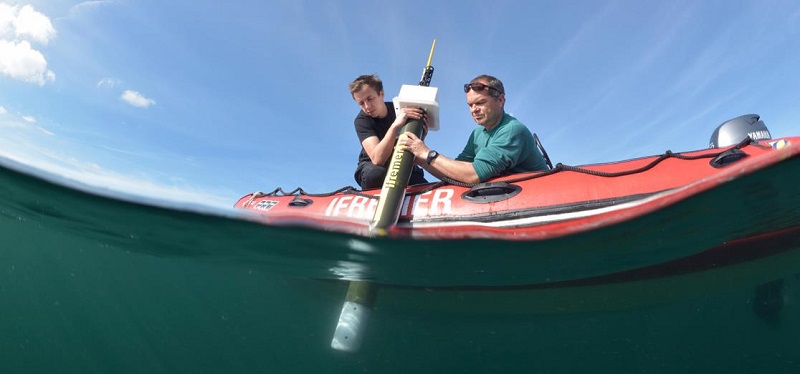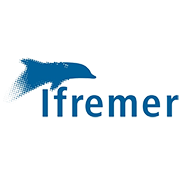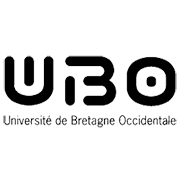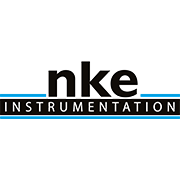Press Release: New autonomous floats to survey the oceans more closely
- September 21, 2020
- Category: Flash info

Co-led by the French institute of marine research and exploration Ifremer and Sorbonne University, the NAOS project (Novel Argo Observing System) selected for the first phase of the EQUIPEX* call for projects initiated under the French government’s future investment programme held its final meeting on 17 September.
The project received €8 million in funding from the national research agency ANR and ran from 2011 to 2020, a 10-year development effort to give France and Europe a new generation of autonomous Argo floats designed to meet the future challenges of ocean observation.
Argo international programme and Europe and France’s contribution
With its 4,000 profiling floats that measure temperature and salinity across the world’s oceans from the surface down to depths of 2,000 metres, the Argo international programme, supported by some 30 nations, has revolutionized global ocean observation. It is the leading in-situ global array surveying the oceans in real time and thus a crucial complement to satellite data in monitoring, understanding and characterizing the impact of climate change on the oceans’ physical and chemical properties and on marine ecosystems.
A legal structure (Euro-Argo ERIC) was set up in 2014 to organize Europe’s contribution to the Argo array. This structure is coordinated by France and counts 12 European member states. France’s contribution is a very large research infrastructure (TGIR**) called Argo France, overseen by the French Ministry of Higher Education, Research and Innovation. Argo France handles coordination, purchasing and deployment of floats, data processing and interfacing with the user community. France contributes to about 10% of the global array and hosts one of the two global processing centres (the Coriolis Global Data Assembly Centre (GDAC) operated by Ifremer).
Sustaining the Argo array over the coming decades is a key science challenge. In his speech opening the 15th maritime economy conference, French President Emmanuel Macron himself underlined Argo’s importance for ocean and climate research.
NAOS EQUIPEX project: stepping up France’s contribution to the European array
New observing tools are also needed to deliver fresh insights into the role of the oceans in regulating Earth’s climate. To meet this need, NAOS has developed and validated a new generation of Argo profiling floats that are more robust, smarter, capable of carrying more sensors (notably for marine biogeochemistry) and reaching the remotest areas like the deep ocean (4,000 metres) and polar regions.
Building on the technical and scientific expertise of the NAOS consortium, three pilot experiments have been conducted:

- Surveying and understanding the biogeochemical status of the Mediterranean Sea. A fragile environment subjected to unprecedented anthropogenic pressures, the Mediterranean basin has been an ideal proving ground for NAOS profiling floats equipped with biogeochemical sensors as instruments of scientific excellence.
- Exploring the dynamics of phytoplankton under the Arctic polar ice. Among the most hostile natural environments on the planet, the Arctic plays a critical role in Earth’s climate machine. Under the ice, life has adapted and phytoplankton has found an ecological niche that is very difficult to observe. Floats developed with NAOS funding and capable of ‘wintering’ under the ice and resurfacing when it melts have been deployed there, in close partnership with Canadian teams with specialist knowledge of the region.
- Observing the dynamics of the Atlantic depths. In the North Atlantic, surface waters that sink towards the bottom are the ‘engine’ driving the global ocean circulation and storage of excess heat and CO2 generated by human activities, thus contributing to the oceans’ role regulating climate. NAOS floats capable of reaching deep layers were deployed to study the ocean circulation there, which is still poorly understood, and its role in redistributing climate signals. The floats were also equipped with oxygen sensors to gauge and understand the ocean’s ability to oxygenate its deeper layers.
Major technological and scientific advances
- France has stepped up its contribution to the global Argo array, deploying 100 floats between 2011 and 2019. This contribution now represents 10% of the total array and 30% of Europe’s efforts.
- The new generation of French Argo floats is delivering greatly improved performance in terms of lifetime and reliability.
- A new float has been developed that is capable of tracking climate change down to the ocean depths (4,000 metres).
- Smart floats have been deployed that are capable of exploring polar regions and detecting ice.
- A first demonstration of an operational array of Argo floats with biogeochemical sensors has been accomplished at ocean basin scale, involving deployment and maintenance of the array, real-time processing and quality control, and data integration in models.
- A first demonstration of the value of Argo floats with biogeochemical sensors has been accomplished to monitor the Arctic Ocean and the evolution of its primary production.
- Remarkable scientific advances have been made in understanding the biogeochemical cycles of the Mediterranean, the Arctic and the deep North Atlantic, with more than 40 scientific publications based on the unique data collected by the three NAOS pilot experiments.
A strong public-private partnership
The NAOS project is built on a strong partnership between Ifremer as project lead, Sorbonne University as co-lead, CNRS, UBO/IUEM***, the SHOM naval hydrographic and oceanographic office and private firms: CLS for satellite telecommunications and SME nke Instrumentation for industrial scale-up, production and marketing of Argo floats manufactured in France.
NAOS has served as a catalyst to consolidate and boost nke’s global competitiveness. Nke is today the number two manufacturer of Argo profiling floats in terms of numbers and active floats. Such strong growth represents a factor-of-two increase in the firm’s market share over the pre-NAOS period. Incorporating Argos-3 technology and analysing its performance for NAOS has proved vital for CLS in preparing its future satellite telemetry services (Argos-4, Kineis).
The future of NAOS: responding to the oceans’ role in a changing climate
On the back of the technological and scientific advances that NAOS has achieved, France is proposing to contribute to the new operational phase of the international Argo programme for 2020-2030 by extending it to the abyssal ocean (Deep Argo) and biogeochemistry (BGC-Argo).
This new phase of Argo will entail high scientific stakes for studying the oceans’ evolution and climate change, with a particular focus on the role of the deep ocean in the planet’s energy budget, the ocean CO2 pump, ocean acidification, deoxygenation and the evolution of ecosystems and living resources. It is also vital for operational ocean monitoring and forecasting by the European Copernicus programme and its marine service led by France (Mercator Ocean International).
Learn more at www.naos-equipex.fr
* Equipment of Excellence
** Très Grande Infrastructure de Recherche
*** Université de Bretagne Occidentale/European Institute of Marine Studies







